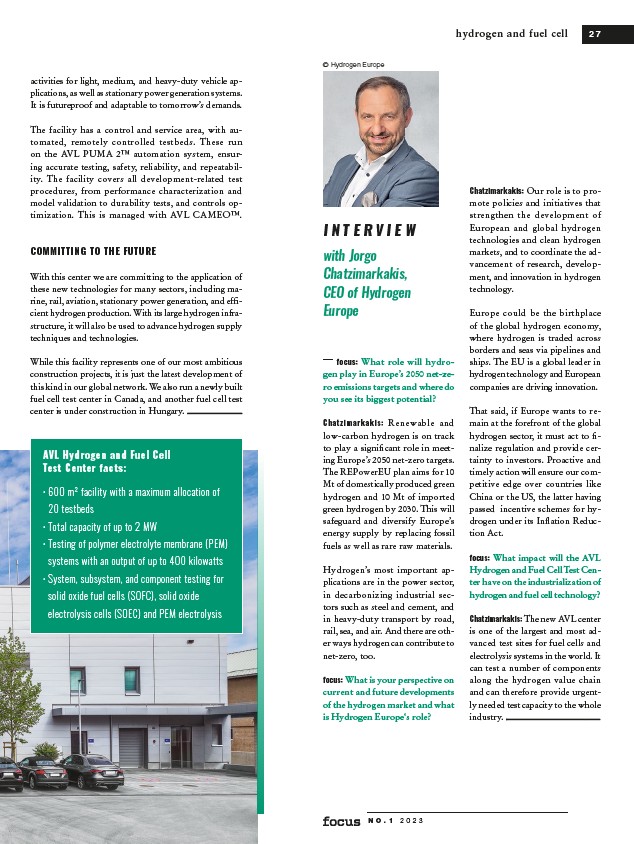
hydrogen and fuel cell 2 7
I N T E R V I E W
with Jorgo
Chatzimarkakis,
CEO of Hydrogen
Europe
focus: What role will hydrogen
play in Europe’s 2050 net-zero
emissions targets and where do
you see its biggest potential?
Chatzimarkakis: Renewable and
low-carbon hydrogen is on track
to play a significant role in meeting
Europe’s 2050 net-zero targets.
The REPowerEU plan aims for 10
Mt of domestically produced green
hydrogen and 10 Mt of imported
green hydrogen by 2030. This will
safeguard and diversify Europe’s
energy supply by replacing fossil
fuels as well as rare raw materials.
Hydrogen’s most important applications
are in the power sector,
in decarbonizing industrial sectors
such as steel and cement, and
in heavy-duty transport by road,
rail, sea, and air. And there are other
ways hydrogen can contribute to
net-zero, too.
focus: What is your perspective on
current and future developments
of the hydrogen market and what
is Hydrogen Europe‘s role?
N O . 1 2 0 2 3
Chatzimarkakis: Our role is to promote
policies and initiatives that
strengthen the development of
European and global hydrogen
technologies and clean hydrogen
markets, and to coordinate the advancement
of research, development,
and innovation in hydrogen
technology.
Europe could be the birthplace
of the global hydrogen economy,
where hydrogen is traded across
borders and seas via pipelines and
ships. The EU is a global leader in
hydrogen technology and European
companies are driving innovation.
That said, if Europe wants to remain
at the forefront of the global
hydrogen sector, it must act to finalize
regulation and provide certainty
to investors. Proactive and
timely action will ensure our competitive
edge over countries like
China or the US, the latter having
passed incentive schemes for hydrogen
under its Inflation Reduction
Act.
focus: What impact will the AVL
Hydrogen and Fuel Cell Test Center
have on the industrialization of
hydrogen and fuel cell technology?
Chatzimarkakis: The new AVL center
is one of the largest and most advanced
test sites for fuel cells and
electrolysis systems in the world. It
can test a number of components
along the hydrogen value chain
and can therefore provide urgently
needed test capacity to the whole
industry. �
activities
for light, medium, and heavy-duty vehicle applications,
as well as stationary power generation systems.
It is futureproof and adaptable to tomorrow’s demands.
The facility has a control and service area, with automated,
remotely controlled testbeds. These run
on the AVL PUMA 2™ automation system, ensuring
accurate testing, safety, reliability, and repeatability.
The facility covers all development-related test
procedures, from performance characterization and
model validation to durability tests, and controls optimization.
This is managed with AVL CAMEO™.
COMMITTING TO THE FUTURE
With this center we are committing to the application of
these new technologies for many sectors, including marine,
rail, aviation, stationary power generation, and efficient
hydrogen production. With its large hydrogen infrastructure,
it will also be used to advance hydrogen supply
techniques and technologies.
While this facility represents one of our most ambitious
construction projects, it is just the latest development of
this kind in our global network. We also run a newly built
fuel cell test center in Canada, and another fuel cell test
center is under construction in Hungary. �
AVL Hydrogen and Fuel Cell
Test Center facts:
• 600 m² facility with a maximum allocation of
20 testbeds
• Total capacity of up to 2 MW
• Testing of polymer electrolyte membrane (PEM)
systems with an output of up to 400 kilowatts
• System, subsystem, and component testing for
solid oxide fuel cells (SOFC), solid oxide
electrolysis cells (SOEC) and PEM electrolysis
© Hydrogen Europe